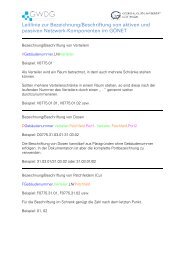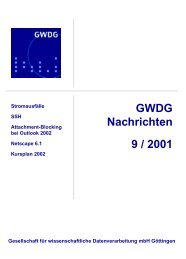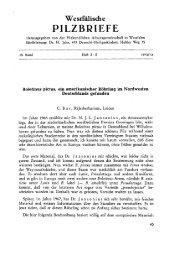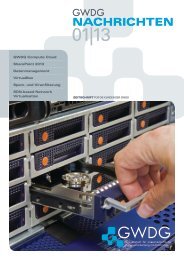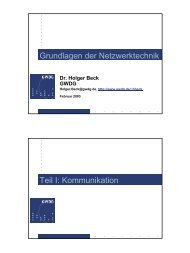Forschung und wissenschaftliches Rechnen - Beiträge zum - GWDG
Forschung und wissenschaftliches Rechnen - Beiträge zum - GWDG
Forschung und wissenschaftliches Rechnen - Beiträge zum - GWDG
Sie wollen auch ein ePaper? Erhöhen Sie die Reichweite Ihrer Titel.
YUMPU macht aus Druck-PDFs automatisch weboptimierte ePaper, die Google liebt.
via parameter lists of the subroutines.<br />
The user interface is implemented by using the Fortran95 namelist constructs,<br />
and is connected to the three layers BMIL, SMIL, and SMCL.<br />
The global switches to turn the submodels on and off are located in the<br />
BMIL. These switches for all submodels are set by the run script.<br />
Submodel-specific data initialization (e.g. initialization of chemical species<br />
(=tracers)), and import of data within the time integration (e.g. temporally<br />
changing bo<strong>und</strong>ary conditions) using the data import interface are handled<br />
by the SMIL. Within the SMIL, also the coupling options from the user interface<br />
are evaluated and applied, which control the coupling of the submodel to<br />
the base model and to other submodels. For instance, the user has the choice<br />
to select the submodel input from alternative sources, e.g. from results calculated<br />
online by other submodels, or from data provided offline. Therefore,<br />
this interface allows a straightforward implementation and management of<br />
feedback mechanisms between various processes.<br />
The control interface is located within the SMCL and manages the internal<br />
complexity (and with this also the output) of the submodel. It comprises, for<br />
instance, changeable parameter settings for the calculations, switches for the<br />
choice of different parameterizations, etc.<br />
A model simulation of a typical base model/MESSy setup can be subdivided<br />
into three phases (initialization phase, time integration phase, finalizing<br />
phase), as shown by the simplified flow chart in Fig. 4. The main control<br />
(time integration and run control) is hosted by the base model, and therefore<br />
the base model is also responsible for the flow of the three phases. After the<br />
initialization of the base model, the MESSy infrastructure with the generic<br />
submodels is initialized. At this stage the decision is made which submodels<br />
are switched on/off.<br />
Next, the active MESSy submodels are initialized sequentially. This initialization<br />
is divided into two parts (not explicitly shown in Fig. 4). First, the<br />
internal setup of all active submodels is initialized, and second the potential<br />
coupling between all active submodels is performed. After the initialization<br />
phase the time integration (time loop) starts, which is controlled by the base<br />
model. All MESSy submodels are integrated sequentially according to the<br />
operator splitting concept. At the end of the time integration, the MESSy<br />
submodels and the MESSy infrastructure are finalized before the base model<br />
terminates.<br />
4 MESSy Submodels<br />
Many submodels are now available within the MESSy system. Some of them<br />
are completely new code whereas others have been adapted to MESSy based<br />
18



